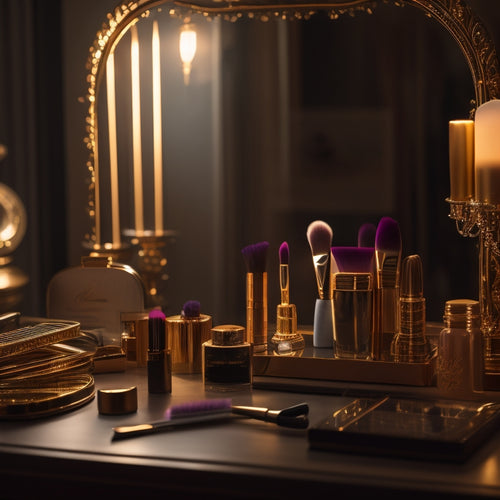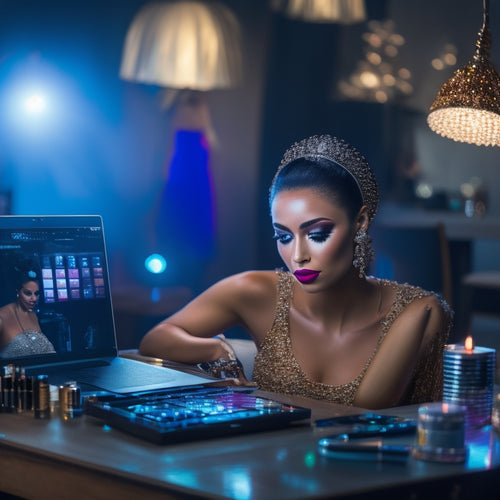5 Essential Digital Makeup Tips for Dance Teachers
Share
You'll enhance your dance students' confidence to the next level by mastering five essential digital makeup skills. First, grasp color theory and skin analysis to select flattering shades. Then, choose the right digital tools that fit your teaching style. Next, learn contouring techniques to accentuate facial features and create the illusion of defined facial structures. After that, perfect complexions with swift strokes and focus on evening out skin tones. Finally, elevate your dance makeup game by mastering subtle contouring and highlighting techniques. Discover the secrets to stunning digital makeup designs that empower your students to shine on stage.
Key Takeaways
• Select digital tools with adjustable brushes and realistic textures to achieve a natural, flawless look for dance performances.
• Analyze skin undertones to choose harmonious shades that complement dancers' complexions and enhance their natural beauty.
• Master subtle contouring and highlighting techniques to add depth and dimension to facial features without looking overdone.
• Use skin-smoothing filters and the 'Spot Healing' tool to perfect complexions and conceal blemishes quickly and efficiently.
• Focus on enhancing facial symmetry and accentuating dancers' best features to boost their confidence and stage presence.
Mastering Digital Makeup Fundamentals
To effectively teach digital makeup techniques to your dance students, you must first grasp the fundamental principles of digital makeup itself, including understanding color theory, lighting, and texture manipulation. Mastering these basics is essential to creating realistic and stunning digital makeup designs.
Color theory is an important aspect of digital makeup, as it enables you to select harmonious colors that complement your students' skin tones. You'll need to understand how to analyze skin undertones, whether they're cool, warm, or neutral, to choose the most flattering shades.
Skin analysis is a critical step in this process, as it helps you identify the undertones and determine the most suitable color palette for each student.
Choosing the Right Digital Tools
Choose a digital makeup software that aligns with your teaching style and student needs, as this decision will greatly impact the quality of your digital makeup instruction.
You want a tool that complements your unique approach to teaching dance, while also catering to the diverse needs of your students.
When selecting a digital makeup software, consider the following essential factors: ease of use, customization options, and compatibility with your devices. A user-friendly interface will save you time and reduce frustration, allowing you to focus on what matters most - teaching.
Your digital makeup toolbox essentials should include software that offers a range of features, such as adjustable brush sizes, customizable palettes, and realistic texture options. Look for software that provides shortcuts, enabling you to work efficiently and effectively. Software shortcuts will allow you to quickly access frequently used tools, streamlining your workflow and enhancing your overall teaching experience.
Enhancing Features With Digital Contour
By incorporating digital contouring techniques into your teaching, you'll be able to accentuate your students' facial features and create a more realistic, polished look.
Contouring is all about creating the illusion of defined facial structures, and with digital tools, you can achieve this without the need for heavy makeup.
To start, focus on enhancing facial symmetry by identifying the areas of the face that need definition. Use digital brushes to add subtle shadows and highlights that create the illusion of structure.
Be cautious of common contouring mistakes, such as over-contouring or contouring in the wrong areas. Remember, the goal is to enhance, not to drastically alter.
Pay attention to the shape of your students' faces and tailor your contouring techniques accordingly. For instance, if a student has a round face, use contouring to create the illusion of length.
Creating Flawless Skin in Minutes
With a few swift strokes, you can perfect your students' complexions in mere minutes, transforming their skin from imperfect to immaculate. As a dance teacher, you understand the importance of a flawless base in digital makeup. It's the foundation upon which all other enhancements are built. To achieve this, focus on evening out skin tones, concealing blemishes, and adding a touch of radiance.
Begin by applying a subtle skin-smoothing filter to soften pores and fine lines. Next, use the 'Spot Healing' tool to gently erase imperfections, working from largest to smallest. For a natural-looking finish, blend, blend, blend! Remember, the goal is to enhance, not mask. A gentle hand is key.
Incorporate these Skin Secrets into your Morning Routine to make sure your students look and feel their best. By streamlining your process, you'll have more time to focus on the fun stuff – like highlighting those bright, beaming smiles!
Elevating Your Dance Makeup Game
You're now ready to take your students' digital makeup looks to the next level by mastering the art of subtle contouring and highlighting, which can add depth, dimension, and dynamism to their features. By enhancing their natural beauty, you'll help them exude Dance Confidence and embody their Performance Persona. To achieve this, focus on accentuating their best features while subtly defining their facial structure.
| Feature | Contour | Highlight |
|---|---|---|
| Cheekbones | Soft, gentle shading | Subtle glow on high points |
| Nose | Slight definition | Tip of the nose, bridge |
| Eyes | Soft, natural shading | Brow bone, inner corners |
When contouring, use a light hand and blend, blend, blend! For highlighting, apply subtle, targeted highlights to create a natural-looking glow. By mastering these techniques, you'll help your students shine with confidence and own the stage with their Performance Persona.
Frequently Asked Questions
Can I Use Digital Makeup for In-Person Dance Performances?
'You'll find digital makeup unsuitable for in-person dance performances, as it's designed for virtual applications. Instead, conduct in-person trials to test traditional makeup, respecting makeup boundaries to guarantee a flawless, sweat-resistant look that enhances your performance.'
How Do I Prevent Digital Makeup From Looking Fake on Camera?
"Can you truly master the art of digital makeup? To prevent a fake look, you adjust lighting angles to accentuate natural skin textures, and subtly blend digital enhancements to create a seamless, camera-ready finish."
Are Digital Makeup Skills Transferable to Real-Life Makeup Artistry?
As you shift from digital to real-life makeup artistry, you'll find your skills translate seamlessly, offering artistic expression, real-world applications, and creative freedom, ultimately enhancing your professional development and ability to serve others.
Can I Monetize My Digital Makeup Skills as a Dance Teacher?
"Just like a master chef whipping up a culinary storm, you can monetize your digital makeup skills by expanding your brand through online courses, leveraging social media to showcase your expertise, and attracting a loyal following."
Do I Need to Be Tech-Savvy to Learn Digital Makeup Skills?
You don't need to be extremely tech-savvy to learn digital makeup skills; basic training through online courses can help you grasp the fundamentals, and with practice, you'll become proficient in no time.
Related Posts
-

Top Dance Makeup Tools for Perfect Stage Looks
To create a flawless stage look, you'll need the right tools and techniques. Start with high-quality makeup brushes, ...
-

Get Started With Dance Makeup: a Beginner's Guide
You're about to start on a creative journey that combines your passion for dance with the art of makeup. To get start...
-

5 Essential Tips for Online Dance Makeup Success
You're about to discover the secrets to a thriving online dance makeup presence. First, establish a strong online fou...


